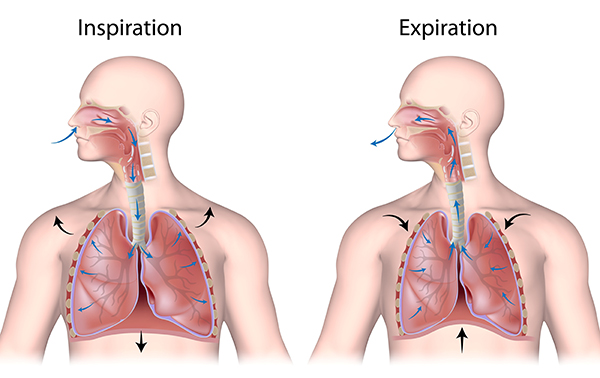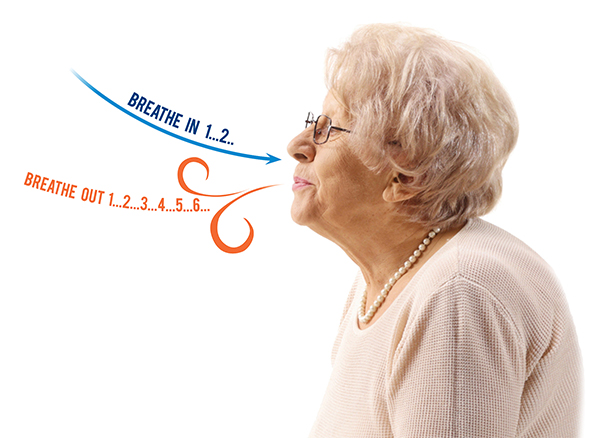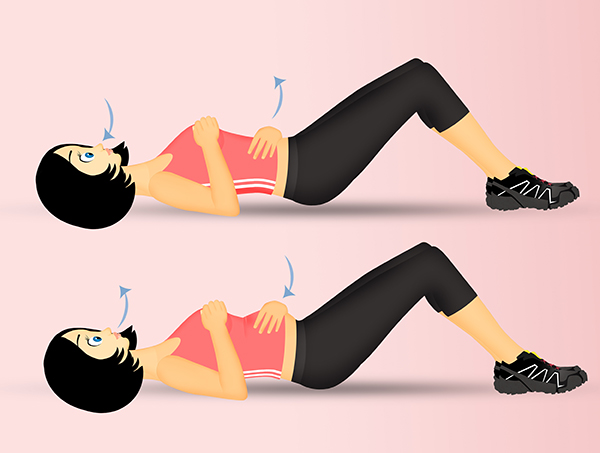Breathing Techniques
The lungs bring oxygen into the body (inhaling) and remove carbon dioxide from the body (exhaling). In advanced stages of bronchiectasis and nontuberculous mycobacterial (NTM) lung disease, the lungs may not work as well because of too much mucus clogging the airways. Breathing techniques can be used to reduce the feeling of shortness of breath in bronchiectasis and NTM patients with low lung function. These techniques are also helpful for individuals experiencing a worsening or flare-up of their disease.1 These flare-ups are known as exacerbations. Breathing techniques can be helpful in managing breathlessness during exercise as well.2

Thoracic (thuhr-rAs-ik) Expansion Breathing Technique – This technique focuses on breathing in or inhaling. It is often used as part of the Active Cycle Breathing Technique (used for clearing mucus). However, its t can also be used alone to decrease shortness of breath and prevent the tiny air sacs in the lungs fromcollapsing.3 These tiny sacs are called alveoli.
To use thoracic expansion breathing, take a deep breath in through the nose without using neck and shoulder muscles. Hold this breath for 2-3 seconds and then gently blow out the air. This breathing exercise should be is repeated 5 times.
Pursed-lip Breathing Technique – This technique is used to help improve shortness of breath by slowing the breathing rate and using slight backpressure to prop open collapsed airways. Using pursed lip breathing during exercise may help you breathe more comfortably and maintain oxygen levels.4
To use pursed lip breathing, breathe in through your nose as if you are smelling roses. Then, blow out slowly over 4-6 seconds through pursed lips as if you are blowing out birthday candles.5

Diaphragmatic Breathing or “Belly” Breathing – The diaphragm (die a fram) is the muscle that separates the chest cavity from the stomach. It is considered the main muscle for breathing. As the diaphragm tightens, the lungs expand. In diaphragmatic (die a fram mat tick) or belly breathing, you will use the stomach muscles to assist the diaphragm in the breathing process. This breathing technique may require some training as it may not be as easy to do as the two other techniques listed above.5
To perform belly breathing, the stomach should expand outward as you take a deep breath in through the nose. Then as you exhale through the mouth, the stomach should pull-in. Practice this breathing technique for several minutes a day. It is recommended that you practice belly breathing first while laying down. Then try it while sitting, and next by standing up. Lastly, try this breathing technique during activity.6

**When trying any breathing techniques for the first time, it is best to be rested and relaxed. Breathing techniques should be practiced before use. Talk to your doctor or respiratory therapist about whether you may benefit from learning some breathing techniques.
References:
1Lu Y, Li P, Li N, et al. Effects of home-based breathing exercises in subjects with COPD. Respir Care. 2020;65(3):377-387. doi: https://doi.org/10.4187/respcare.07121.
2Vatwani A. Pursed lip breathing exercise to reduce shortness of breath. Arch Phys Med Rehabil. 2019 J;100(1):189-190. doi: https://doi.org/10.1016/j.apmr.2018.05.005.
3Terry PB, Traystman RJ. The clinical significance of collateral ventilation. Ann Am Thorac Soc. 2016;13(12):2251-2257. doi: https://doi.org/10.1513/AnnalsATS.201606-448FR
4Cabral LF, D'Elia Tda C, Marins Dde S, Zin WA, Guimarães FS. Pursed lip breathing improves exercise tolerance in COPD: a randomized crossover study. Eur J Phys Rehabil Med. 2015;51(1):79-88.
5Dechman G, Wilson CR. Evidence underlying breathing retraining in people with stable chronic obstructive pulmonary disease. Phys Ther. 2001;84(12):1189–1197. doi: https://doi.org/10.1093/ptj/84.12.1189
6The COPD Foundation. Breathing exercises and techniques for COPD. COPD Foundation website. Published 2021. Accessed March 3, 2021. https://www.copdfoundation.org/Learn-More/I-am-a-Person-with-COPD/Breathing-Exercises-for-COPD.aspx